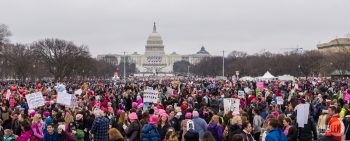January 24, 2017
On Saturday, January 21, 2017, the day after the inauguration of President Donald Trump, 500,000 people gathered in Washington, DC for the Women’s March–to express their unity for women’s issues and to speak out against the demonizing and hateful rhetoric that pervaded the past election cycle. An additional 400,000 marched in New York City , 250,000 in Chicago and according to Women’s March organizers, there were 673 “sister marches” across the country and world. The Women’s March stated: “We stand together in solidarity with our partners and children for the protection of our rights, our safety, our health and our families—recognizing that our vibrant and diverse communities are the strength of our country.”
The Women’s March brought together people from diverse backgrounds and identities, thereby provoking significant discussions in its planning phase, and at the event itself, about intersectionality.
The term intersectionality dates back to 1989 when it was coined by Kimberlé Crenshaw, a law professor at UCLA and Columbia. ADL defines intersectionality as follows:
Intersectionality is a way of looking at the overlap and intersections of people’s social group identities (e.g. race, gender, class, gender identity, religion, sexual orientation, disability, etc.) and addresses the related and intersecting systems of bias, discrimination and oppression.
A useful example of intersectionality is the gender wage gap. If we examine the gender wage gap as a whole, we know that women are paid 80% of what men earn. However, if we dig deeper and ask the right intersectionality questions, we can see that for women of color, that disparity is even greater, 54% for Latina and 63% for African-American women, who earn less than their white (75%) and Asian (85%) counterparts. This information is critical in gaining a full understanding of the gender wage gap, reflecting on how bias and discrimination manifest differently, addressing needs and confronting the inequities.
In the Women’s March’s Guiding Vision and Definition of Principles, intersectionality is addressed explicitly by stating, “Recognizing that women have intersecting identities and are therefore impacted by a multitude of social justice and human rights issues, we have outlined a representative vision for a government that is based on the principles of liberty and justice for all.”
This doesn’t mean the road was smooth or easy. In fact, when the Women’s March was in its planning phase, there were reports of contentious conversations about race almost daily among participants (taking place on Facebook), which were energizing to some and alienating to others. There was controversy over the name of the March and whether it was inclusive enough of women of color who often felt excluded from mainstream feminist movements. The national organizers, a diverse group of four women—African American, Latina, Muslim and White—made the intentional decision to highlight the plight of women of color and undocumented immigrant women because those groups were targeted during the election and because the organizers wanted to spark conversations about race that intersected with gender.
The purpose, values and principles of the Women’s March convey an intersectional platform of issues that impact women, including: racial justice and racial profiling, violence against women, criminal justice system, reproductive freedom, voting rights and freedom of speech, access and inclusion for women with disabilities, LBTQIA rights, workplace protections, pay equity, minimum wage, civil rights, immigration/refugee rights, environmental justice and more. The speakers addressed this collection of issues and the speakers themselves represented diverse communities.
Talking about the Women’s March is a productive way to ignite conversations about intersectionality. Here are some other ways to consider teaching or talking with young people about it:
- For younger elementary age children, introduce them to the concept of identity and engage them in reflecting on the different aspects of identity that make up who they are as well as other people’s identities. A key concept is how we all have more than one identity; the combination of those identities makes us unique and each identity has a different level of importance at different points in our lives.
- As children get older, continue to help them reflect on their own identities as well as others. In addition, they can begin to examine the intersections of different aspects of identity and be able to understand the perspective of others’ identities. Further, when we talk with or teach young people about different forms of bias and discrimination, it is important to point out the intersections that exist, as illustrated in the gender wage gap example described above. Go beyond the surface and ask questions to push their thinking about overlapping identities and biases.
- Have young people reflect upon the Women’s March as well as other examples of social activism throughout the years, using an intersectionality approach. For example, when studying the Civil Rights Movement, help them overlay the lens of gender and sexual orientation to explore how those voices differed and the extent to which they were included or excluded from the movement.










